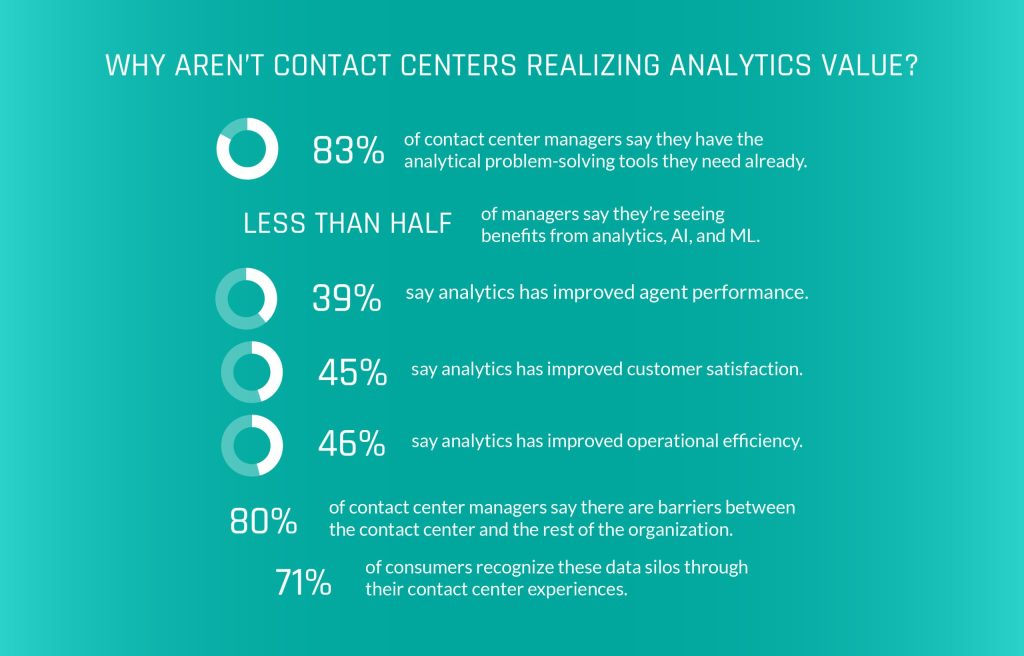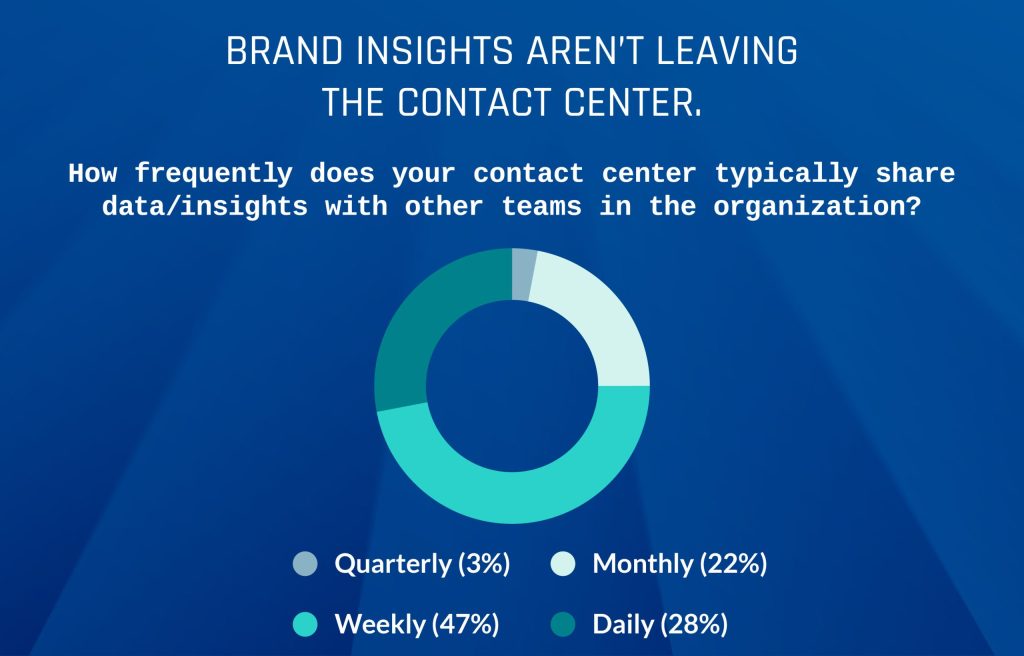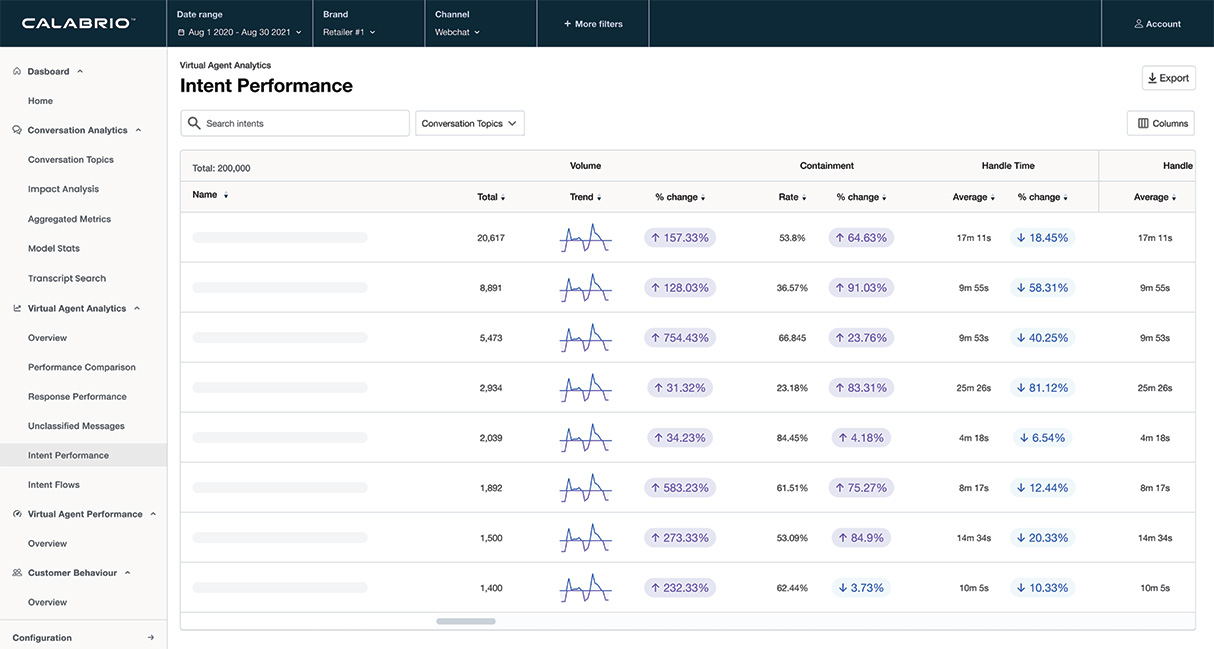Why Most Contact Centers Aren’t Realizing the Potential of Analytics
Why Most Contact Centers Aren’t Realizing the Potential of Analytics

Two mistakes—and three tips—for contact center analytics success
Across the last three years of our State of the Contact Center survey and report, surging adoption of analytics (along with AI and machine learning) has remained a consistent trend. Our 2020 report showed that analytics adoption quickly jumped up above 50%, and Forrester says the majority of companies accelerated their analytics and AI adoption plans through the pandemic period. Analysts say this adoption trend isn’t over: The global contact center analytics market is expected to grow by 11.2% CAGR through 2028.
But our State of the Contact Center 2022 report revealed a puzzling contradiction. The vast majority of contact center managers say they now have the analytics tools in place to solve their most pressing problems. Yet less than half of those same managers say they’re seeing benefits from their analytics, AI and machine learning (ML) technologies.

If these technologies are not delivering on these essential value propositions within the contact center, it’s a safe bet they’re not delivering on their broader potential to drive customer-centric business intelligence across the rest of the organization.
Analytics Tools Need Good Plumbing to Work Well
So, if most contact centers have the analytics tools they need, why aren’t they seeing value?
It’s a plumbing issue.
The major potential of analytics, AI and ML lies in their ability to make sense of the tremendous amount of raw structured and unstructured data that streams into, or is generated by, an organization every day. But those tools depend on good plumbing to work properly. They need robust data pipelines coming into the contact center. Just as importantly, they need data pipelines sending analytics insights back out across the organization—connecting directly into workflows and decision-making processes.
As Forrester put it in their 2022 report on customer service megatrends, “the next wave of business transformation will hinge on activating ‘dark’ data.” That is, “data that organizations collect but do not effectively use.”
As we already alluded to, there are two key reasons many contact centers struggle to activate this dark data.
Problem #1: Data silos disconnect contact centers from deeper insights
Despite all the talk and hype about building the integrated, omnichannel contact center, data silos remain a big problem. Why are data silos problematic? A full 80% of contact center managers say there are barriers between the contact center and the rest of the organization. Even more concerning, 71% of consumers see the negative impacts of these data silos coming through in their contact center experiences. Again, Forrester summed this point up nicely: “The question is no longer about collecting enough data—it’s about ensuring that the data is usable and liberated from company silos to create new streams of value.”
Moreover, today, omnichannel visibility demands pulling in valuable voice-of-customer (VOC) data from beyond the traditional bounds of the contact center. The contact center should be working with web teams to pull in web traffic and on-site behavior data. They should be connecting with social media teams that manage those rapidly growing customer communication channels. And in spite of the push toward digital customer experiences (CX), contact centers can’t overlook the valuable VOC data points that come through the in-store customer service teams that facilitate in-person CX.
But to realize the full potential of analytics, contact center leaders need to look beyond VOC data—pulling in data streams from across the enterprise:
- Sales and CRM data
- Engagement data from digital marketing campaigns
- Customer and business data from physical locations and/or field service delivery teams
- Data from front- and back-end operational systems (POS, inventory management, service dispatch and case management, supply chain, finance, etc.)
What are the connections, trends, and insights to be gleaned from connecting these seemingly unrelated data streams? That’s really the core value of analytics, AI and ML: These tools can see connections that humans never could, enabling those humans to find connections in places they traditionally wouldn’t have bothered to look.

Problem #2: Contact center insights go unseen, unheard and unused
Past years’ State of the Contact Center surveys show contact center managers continue receiving more and more requests from across the enterprise. Marketing, sales, operations, finance, and even the C-suite are asking for custom reporting and analytics insights.
But contact centers can’t wait to be asked for these insights. And relying on quarterly, monthly, or even weekly reporting means missing a tremendous number of real-time opportunities to take action—whether that’s fixing an urgent problem, averting an emerging risk, or jumping on the chance to deliver on budding customer demand and get ahead of the competition.
In today’s dynamic business environment, conditions change rapidly, and the first hints of these changes often show up in the VOC. Every team in the organization needs to be empowered with up-to-date customer intelligence.
Leading contact centers are already leveraging embedded analytics and AI to make workflows smarter and more predictive for agents. Now, they need to be building those same types of analytics-powered workflows and decision-making processes across the rest of the organization: to shape marketing campaigns, refine sales strategies, inform inventory and service delivery decisions, and even guide rapid innovation for product and service development—all in near-real time.
3 Tips for Analytics Success
- Make the contact center the hub of business intelligence
The good news here is that everyone knows data silos are a problem. It seems the sticking point is where to start—or, more specifically, where to place the center of your integrated data analytics program.
Every enterprise system and platform today—CRM, ERP, eCommerce, etc.—claims that it should be your single source of truth. But with every brand today driving toward greater customer-centricity, the goal of data integration is 360° customer visibility. That makes the contact center—the biggest source of VOC data and insights—the natural hub for customer-centric business intelligence.
2. Seek out platforms that make it easy to break down silos and integrate data
Another stall point for data integration is the actual process of integrating disparate data streams into a central hub. Again, nearly every enterprise software platform today says it should be that central hub. But many aren’t built to make this integration fast and easy.
This is particularly true of many contact center platforms. The truth is many legacy contact center technologies were built for a time when the contact center played a peripheral role—where its operations and data were comfortably siloed.
Organizations need to seek out modern contact center platforms that are purpose-built to live up to this new role as the hub of customer intelligence. For example, Calabrio ONE provides pre-built connectors and easy custom integration to build those seamless data pipelines from across the enterprise. And it delivers the AI and ML-powered analytics tools to surface the complex connections, patterns and insights buried within that huge pool of data.
3. Ask the right questions to get actionable answers
One of the most common situations we see is a contact center that has followed the first two best practices detailed here—but their analytics program never gets off the ground. They’ve got the integrated data. They’ve got the tools. But the issue is that even the most user-friendly tools do require intentional application.
In other words, AI and ML are phenomenal tools for answering incredibly complex questions. But contact center and CX leaders still need to provide those guiding questions—to tell the tools what they’re looking for.
Developing the questions to drive your analytics program doesn’t have to be a difficult exercise. In fact, these questions should naturally fall out of key challenges and goals. And once again, the broader potential here lies in asking questions that extend beyond the contact center—whether that means better understanding the impact of marketing campaigns, predicting demand for inventory planning, or using the VOC to guide product development.
Get More Actionable Insights from the State of the Contact Center 2022 Report
The analytics value disconnect is just one of the actionable insights uncovered in our State of the Contact 2022 report. Read the full report to see where contact centers should focus now in order to build next-generation experiences that deepen loyalty and drive revenue.









